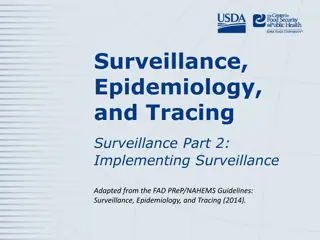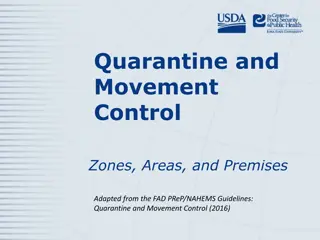Enhancing Biosecurity Measures for Livestock Operations
This presentation explores operational biosecurity measures adapted from FAD PReP/NAHEMS Guidelines, emphasizing the importance of developing an effective biosecurity plan to prevent disease spread. It discusses the three levels of biosecurity, operational processes, and procedures for personnel, ve
0 views • 25 slides
Implementing Surveillance in Epidemiology: Methods and Considerations
This presentation outlines sampling methods and considerations for implementing surveillance in epidemiology. It covers aspects such as sample types, sizes, random vs targeted sampling, and the comparison between the two approaches. The content provides insights into the practical aspects of surveil
1 views • 24 slides
Best Practices for Premises Biosecurity in Production Facilities
Operational recommendations for maintaining biosecurity in production facilities, focusing on bioexclusion and daily management. The guidelines cover the implementation of effective procedures, assigning responsibility and authority, role of a biosecurity officer/manager, training personnel, and ens
0 views • 26 slides
Epidemiology Investigation and Response in FAD Outbreaks
This presentation covers the phases of epidemiological investigation in Foreign Animal Disease (FAD) outbreaks, including the descriptive, analytic, and intervention phases. It discusses the collection of information, diagnostic testing, disease risk factors, associations, and identifying the FAD ag
1 views • 14 slides
Guidelines for Surveillance, Epidemiology, and Tracing Personnel and Premises Designations
This presentation provides an overview of necessary personnel, incident command, planning sections, and premises designations based on the FAD PReP/NAHEMS Guidelines for Surveillance, Epidemiology, and Tracing. It covers topics such as the Incident Command System, Planning Section, and Operations Se
0 views • 22 slides
Guidelines for Quarantine and Movement Control Zones and Premises
This presentation outlines the designation of zones, areas, and premises as per the FAD PReP/NAHEMS guidelines for quarantine and movement control. It covers the establishment of control areas, minimum sizes of zones, and premises designations including infected, contact, suspect, and at-risk premis
0 views • 16 slides
Understanding Biosecure Areas in Livestock Management
This presentation showcases examples of biosecure areas in livestock management, emphasizing the importance of separating uninfected and infected premises to prevent the transfer of diseases. The guidelines outlined by FAD PReP/NAHEMS stress the need for a clear line of separation and strategic prot
0 views • 17 slides
Biosecurity Cleaning and Disinfection Guidelines
The presentation covers the essential components of biosecurity plans, focusing on Cleaning and Disinfection (C&D) as well as Biosecurity Attire/Personal Protective Equipment (PPE). It includes detailed information on C&D methods, processes, and factors affecting disinfecting efficacy, as per the FA
0 views • 19 slides
Health and Safety Incident Reporting Guidelines
Learn about incident reporting procedures adapted from the FAD PReP/NAHEMS guidelines for health and safety incidents. Find out the steps to take when an incident occurs, including reporting requirements, documentation, and workers' compensation processes.
0 views • 14 slides
Thermal Disposal Methods for Animal Carcasses: Guidelines and Best Practices
Explore thermal disposal methods adapted from the FAD PReP/NAHEMS Guidelines for effectively managing animal carcasses. Learn about high-temperature combustion, fixed-facility incineration, open-air burning risks, and air-curtain incineration techniques. These methods vary in efficiency, environment
0 views • 17 slides
Tracing in Animal Disease Control: Guidelines and Procedures
This presentation delves into the importance of tracing in animal disease control, covering trace-back and trace-forward methods, sources of information, collaboration services, and the role of livestock owners. It highlights the guidelines and operational procedures adapted from FAD PReP/NAHEMS, fo
0 views • 27 slides
Guidelines for Disposal Group Responsibilities and Activities
Responsibilities and activities of the disposal group adapted from FAD PReP/NAHEMS guidelines include roles such as disposal method recommendations, organizing and directing activities, ensuring procedures are carried out, and performing disposal tasks. The group aims to mitigate pathogen spread, sa
0 views • 16 slides
Guidelines for Quarantine and Movement Control
Movement control measures are crucial in preventing the transmission of pathogens and maintaining business continuity. This presentation outlines the procedures for permitting and authorizing movements, along with general personnel responsibilities based on FAD-PReP/NAHEMS guidelines. It covers rest
0 views • 28 slides












